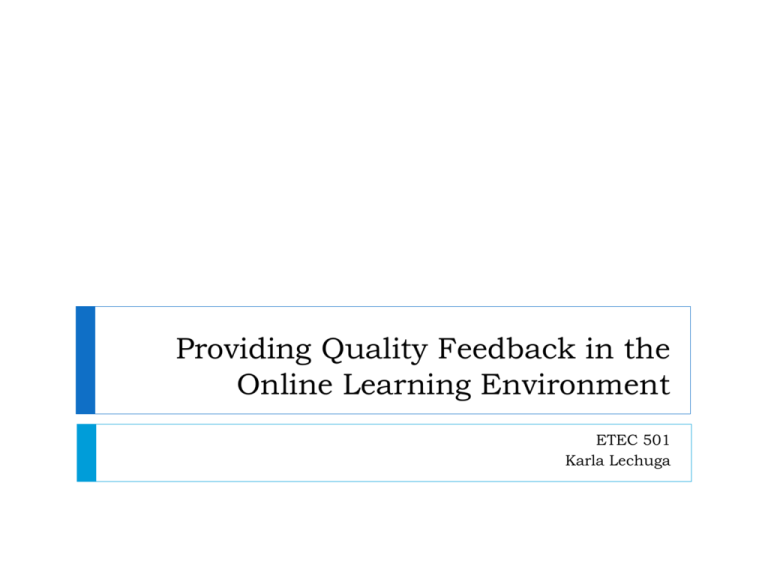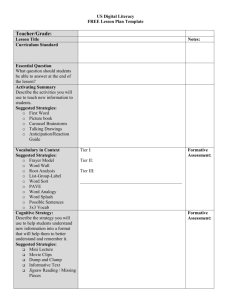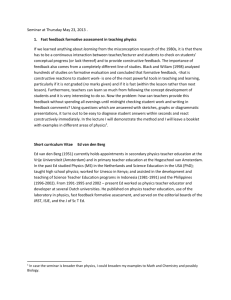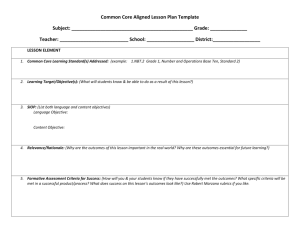Providing Quality Feedback in the Online Learning
advertisement

Providing Quality Feedback in the Online Learning Environment ETEC 501 Karla Lechuga How many times have you used one of the following phrases below when you provide feedback to the students regarding their work? This Presentation will… Provide background information on Assessment and Formative Feedback Provide Principles of Quality Instruction Explain what is Feedback, and how feedback can influence student achievement. Explain how quality feedback can improve learning. Provide 5 recommendations for providing quality feedback in an online learning environment. Assessment and Formative Feedback Summative and Formative Assessment Assessment is divided into two categories: summative, and formative. Summative assessment is evaluative, and is provided by the instructor at the end of the course typically through a letter grade. Formative assessment is diagnostic, and provided continuously throughout the length of the course by the instructor or a peer. Formative assessment is not used as an evaluative method to assign student grades, it is used to provide students with formative feedback regarding student’s work. Robert Stake, educational researcher, explains “When the cook tastes the soup, that's formative. When the guests taste the soup, that's summative.“(Educational Assessment, 2010). Cauley and McMillan explain that “effective teachers” use formative assessment throughout the course to: Identify specific misunderstandings the student may have regarding the assignment. Provide feedback to help students. Revise current instructional methods to help students better understand the goals and objectives of the assignment. (Cauley, and Mc Millan, 2010). More on Assessment Garrison explains that “ assessment occurs throughout the course, thereby providing formative feedback to students…on their progress toward attaining educational goals and objectives.”(Garrison, 100-102). Regarding the importance of feedback in an online environment Garrison explains that “students need feedback and direction for cognitive reasons or because of time constraints and the need to expedite the educational process.” (Garrison, 97). Research shows that students are “more likely to increase effort when the intended goal “is clear, when high commitment is secured for it, and when the belief in eventual success is high.” (Hattie and Timperley, 86) Seven Principles of Quality Instruction Chickering and Gamson’s identify seven principles of quality instruction in undergraduate education. These principles have proven to engage students, and motivate them to learn. They include: 1. Frequent student/teacher interaction. 2. Collaborative learning. 3. Using active learning techniques. 4. Providing prompt feedback. 5. Emphasizing time on task 6. Communicate high expectations 7. Respect diversity (Abdul-Hamid, Lewis, 84) Five Learning Principles for Effective Online Instruction Hacker and Niederhauser identify five principles for effective online instruction, and enhancement of student learning outcomes. They include: 1. Students must actively participate in their learning. 2. Prepare students by providing examples. 3. Use collaborative problem solving 4. Providing appropriate feedback 5. Motivate students, and provide opportunities to enhance student self-efficacy. (Abdul-Hamid, Lewis, 84) Four Strategies of Effective Online Teaching 1. 2. 3. 4. In 2005 the University of Maryland University College (UMUC), leader in distance education, provided more than 500 courses, 80 degree programs, and an enrollment total of 87,000. A study of a total of 30 undergraduate, and graduate faculty teachers at (UMUC), was compiled to determine what practices were being implemented, and what the faculty teachers felt contributed to the success in the online learning environment. The findings were broken down into four categories which include: fostering interaction providing feedback, facilitating learning maintaining enthusiasm and organization. (Abdul-Hamid, Lewis, 85) Feedback? As we can see providing prompt and appropriate feedback is delineated within Chickering and Gamson’s “Seven Principles of Quality Instruction,” and in Hacker and Niederhauser “Five Learning Principles for Effective Online Instruction.” Feedback is also listed among one of the four strategies used in successful online instruction. But what is feedback, and how can it improve learning? What is the value of providing feedback to the students, and what strategies can be used to provide effective feedback in an online learning environment? The following slides were created in an attempt to answer these questions, and to reflect on the findings of many published articles and peer-reviewed journals. Feedback Feedback is defined as “as information provided by an agent (e.g., teacher, peer, book, parent, self, experience) regarding aspects of one’s performance or understanding.” (Hattie & Timperly, 81). In a traditional classroom environment the teacher can provide formative feedback in one or more ways. Some examples include: Visual- Teachers use visual cues such as a smile, a thumbs up, and or a nod to let the student know how they are doing. Verbal- Teachers use short expressions like “good job,” or “You are on the right track, keep on trying” to let the student know how they are doing in the class. Written- Teachers can provide written feedback that points out what student did well, and what areas need to be improved. In an online learning environment the teacher can also provide verbal and written feedback, but lacks the immediacy or verbal and visual cues that the traditional classroom provided. That is why feedback in an online learning environment is critical to student success because of the isolated nature of the course. Why is Feedback Important? Feedback is critical at all stages of learning because it allows the learner to view their progress, and ways in which they can improve. In order to help students self-assess (based on the learning goals and objectives) the feedback provided by the teacher should be clear and detailed enough to allow students to see what parts of the assignment are correct, and which ones are not. Danielson, Fluckiger, Pasco, and Tixier, state that “Formative feedback furthers student learning as the student engages in a continuous loop of self-assessment based on particular criteria.” They further explain that “effective formative feedback must be specific, simple, descriptive and focused on the task” (Danielson, et al. ,2009). From their research Guskey(1996), Shutte (2007), and Stiggins (2008) suggest that formative feedback is provided to the student as follows: Product- assignment . Process- how the assignment is done. Progress- improvement over time. (Danielson et al., 2009). Influence of Feedback on Student Achievement Hattie and Timperly (2007) Research shows that there is a correlation between the feedback provided to the student, and their achievement. Furthermore studies show that some forms of feedback are preferred more than others. Database information compiled by Hattie(1999) showed a direct relationship between feedback and student achievement. In a summary of 12 meta-analysis (196 studies, and 6, 972 effect sizes), the average effect size was 0.79 which placed feedback among the top 5 to 10 highest influences on student achievement. Table 1 on next slide. Further research of 74 meta-analysis (7,000 studies, and 13,370 effect sizes), demonstrated that the most effective forms of feedback provided support and detailed information about what the student needs to do. The most effective forms of feedback included cues (1.10), feedback (.95), reinforcement (.94), video or audio feedback (.64), and computer-assisted instructional feedback (.52). Table 2 on next slide. The least effective feedback methods in enhancing student achievement included: rewards (0.31), punishment (0.20), praise (0.14), and programmed instruction (-0.04). Influence of Feedback on Student Achievement Hattie and Timperly Influence of Feedback on Student Achievement Cauley and McMillan Research supports the importance of providing feedback to the student, but not just any kind of feedback. Cauley and Mc Millan, explain that feedback can affect how students internalize their achievement , and categorize these goals into performance, and mastery goals. The first being ego-centric, while the second promotes “learning, understanding, improving, mastering new skills, and taking on challenges.” Performance Goals Mastery Goal Students are compared to other students based on their work! Students are encourage to try again, and learn from their mistakes! Teachers that promote performance goals provide feedback publicly and assess student work by comparing the work of one student against another. Performance goals reward students who perform better than others, and assess student based on their ability to perform the task. Teachers that promote mastery goals assess student work using a variety of evaluation methods, and provides feedback privately to allow the student to analyze how the student has progress through the assignments, and provides opportunities to revise, and improve. Influence of Feedback on Student Achievement Cauley and McMillan (2010) Mastery Goals: Assess individual goals, take into consideration the active participation of the student and provide “positive” feedback and strategies. Research shows that students who pursue mastery goals are intrinsically motivated to learn, are more persistent when they face challenging tasks, and display positive accomplishments and make use of deeper cognitive strategies. Performance Goals: Highlights student’s ability to perform, and rewards students who outperforms others. Research shows that students who pursue performance goals are extrinsically motivated to learn, and therefore are more concerned about the rewards that can be obtained as a result of accomplishing the task. Furthermore they are concerned about how their work compares to work of others. They are most likely to procrastinate, and in some cases cheat on their assignments. Purpose of Providing Quality Feedback Price, Donovan, Handley, and Miller state that “more feedback does not always equal more learning…feedback identifies a gap between what is understood/ has been demonstrated and the standard of performance expected” Therefore it is important to clarify at all times the purpose of providing feedback to the student. It is equally important that both teacher and student understand what feedback is trying to achieve for it to be successful. (Price, et al. 2010) Garrison explains that providing students with assessment and formative feedback allows students to learn in a deep and meaningful manner. Garrison also explains that in order for assessment and feedback to be effective they must both match the learning objectives and goals of the intended outcomes. For example, in an online learning environment “if the goal is to realize deep understanding of the concepts and develop critical thinking abilities, the focus of assessment must be understanding and thinking,” (Garrison, 100-101). 5 recommendations for Providing Quality Feedback Defining Quality Feedback and Poor Feedback Feedback “put(s) things right by taking corrective action. Quality Feedback Poor Feedback •Feedback is descriptive and provides enough details so that the student can self-assess, and self-correct. Comments are tailored and highlight the good and what needs to be corrected. For example: “your points support your claims, can you elaborate more on why you agree with the evidence?” •Is given with enough time to allow students to improve the task if necessary. •Focuses on task, not behavior or performance. •Feedback is given in a form of a letter grade, or with vague comments like “add more references,” or “well done.” •Feedback provided towards the end of the course with no possibility for student improvement, or no feedback provided at all. •Compares student work to the work of other students in the class. •Highlight only the wrong, and not the right. #1 Set the Stage and be Specific Post syllabus at the beginning of the class and include the learning goals and objective, and student expectations. Include assignments, due dates, and evaluation criteria (rubrics, point system, quiz, etc.) that tells the student how each assignment ( essays, participation, creation of a product) will be graded. Let the students know which assignment will take more time to elaborate, so that the student can plan ahead of time to elaborate quality work. Research shows that when students have clear learning targets and models of strong and weak student work, and when feedback is continuous, students have a foundation that helps them to understand what they are learning, set goals , and selfassess. #2 Timing Timing is crucial in an online learning environment, especially if the task requires correction. Determine how much, when, how, and why you (the instructor) will provide feedback, and provide this information to the student at the beginning of the course. How much: Explain how much feedback will be provided and whether it will be individual (formative), or to the group (summative) via the LMS. Also, let the students know that you (the teacher) will not provide feedback on all assignments. When: Students are busy, setting a scheduled time will give them time to plan accordingly. Explain when the feedback will be delivered (within 24 hours, 2 days, 1 week), and maintain the same schedule for the remainder of the school year. Don’t provide feedback at the end of the course, give students time to rectify their work. How: Prepare students so that they have the necessary tools. Explain what method of delivery will be used (e-mail, discussion forum, text-based chat, and telephone). Why: Not all students will know what to do with the feedback that you are providing to them. Explain why you are providing feedback (to ensure receipt of work, or to provide suggestions for improvement). Donovan, Handley, Miller and Price explain that if feedback will be used to inform students about the errors in their work, then ensuring a receipt will be a measure of effectiveness. However, if the goal is to help students develop their understanding, and requires correction, then more complex measures will be used to ensure future learning. (Donovan et al., 2010). #3 Provide Examples To promote higher-order thinking skills online teachers design learning assignment that engage students, and motivate the student to want to further explore the topics. Most instructors use the discussion forum (as part of the learning assignment) and post open-ended questions and instruct students to “think critically” and provide “meaningful” comments. Students are required to provide feedback to their peers, thus promoting a collaborative learning and creating an active learning environment. In the discussion forum students are the ones in charge of providing feedback, not the teacher. However, for some students this will be the first online class they have ever taken, and they might not know how to formulate their response. Teachers cannot just say “Think critically and expect students to understand how to do it.” (Danielson Fluckiger, Pasco, Tixier, 139). Teachers should provide examples and models that students can rely on to seek specific information on what the teacher is looking for from the assignment. Examples are powerful because they enable students to more fully understand where they are going and why the teacher provides feedback. For example: teachers can post an example in the discussion forum on how to cite their work, and how to relate their comments to the assigned readings. In addition, teachers can post examples of good quality work from students work from previous semesters. #4 Provide Specific Individualized Feedback A group of 30 online teaching faculty experts from University of Maryland University College concurred that “all students regardless of their performance…are given individualized feedback and individualized feedback…of how they are doing at every stage of the course.” One instructor in particular explained that he used feedback to encourage bright students to maintain the quality of their work, and to encourage those who are not doing so well to motivate them to improve their work (Abdul-Hamid, Lewis, 90). Quality feedback employs using descriptive feedback, with tailored comments about students progress in the assignment. It also provides information regarding the areas that are correct, and those that need improvement. Recommendation #5 Check for Understanding In their research Handley, Millar, O’Donovan, and Price found that students referred to feedback as “…just some notes on a piece of paper…but I don’t always understand what they have written.” (Handley et al., 282). Interpreting feedback is often a hard task for students, and even harder is trying to figure out what to do with the information. That is why teachers need to check for understanding. Once feedback is provided the teachers should provide opportunities for open dialogue to clear any misunderstanding regarding the content of the feedback, and to help students understand what they should do with the feedback they have obtained. Teacher can follow up via e-mail, telephone, text-based chat, video-conferencing. Sometimes a simple phone call from teacher to student, and vice-versa can clarify more than a text message, or an e-mail. Feedback in a Nutshell Effective Feedback Identifies a gap between what is understood/ has been demonstrated and the standard of performance expected. Is diagnostic, and provided continuously throughout the length of the course by the instructor or a peer. Is not used as an evaluative method to assign student grades. Is used to provide students with information regarding student’s progress and keeps them on task. Avoids comparing the work of one student against another, because the level of expertise and skill set will vary among all students. Is given in a timely and recurring manner. Encourages student intrinsic motivation to learn. Empowers student and promotes open dialogue between teacher and peers. References Abdul-Hamid, H., Lewis, C. (2006). Implementing effective online teaching practices: voices of exemplary faculty. Innovative Higher Education, 83-98. Brandenburg,T.,Yu, Chien. (2006). I would have had more success if…:the reflections and tribulations of a first-time online instructor, 32 (1), p43-52. Cauley, K.M., McMillan, J.H. (2010). Formative assessment techniques to support student motivation and achievement. Heldref Publications, 1-5. Danielson, K., Fluckiger, J., Pasco, R., Tixier,Y. (2009). Formative feedback: involving students as partners in assessment to enhance learning. College Teaching, 136-140. Garrison, R. (2011). E-learning in the 21st century. New York, NY, Routledge. Handley, K., Millar, J., O’Donovan, B., Price, M. (2010). Feedback: all that effort, but what is the effect. Assessment &Evaluation in Higher Education, 277-289. Hattie, J., Timperly, H. (2007). The power of feedback. American Educational Research Association, 77(1), 81-112. Educational Assessment (2011). http://en.wikipedia.org/wiki/Educational_assessment



